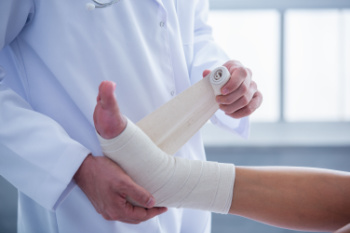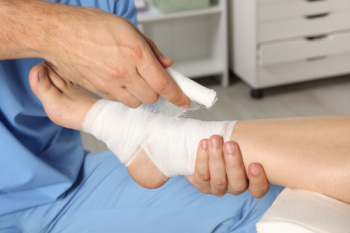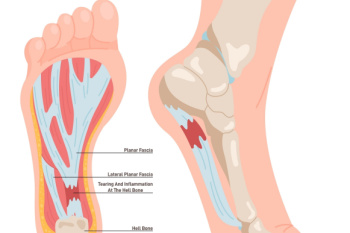Merrillville, IN
Munster, IN

Your feet are made up of 26 bones, and any of them can break under the right circumstances. Foot fractures can happen suddenly from trauma, like a fall or dropping something heavy on it, or develop over time as stress fractures from repetitive activity. Common signs include pain, swelling, bruising, and difficulty putting weight on the affected foot. Prompt diagnosis is essential. A podiatrist will assess your symptoms and may order X-rays or other imaging tests to determine the type and severity of the fracture. Treatment varies depending on the location and extent of the injury. Minor fractures may heal with rest, immobilization in a boot or cast, and avoidance of weight-bearing activities. More complex breaks may require surgery to realign and stabilize the bones. If you think you have broken a bone in your foot or have persistent pain after an injury, it is suggested that you schedule an appointment with a podiatrist for a proper diagnosis and personalized treatment plan.
A broken foot requires immediate medical attention and treatment. If you need your feet checked, contact Ahmad Elsamad, DPM from The Institute of Foot & Ankle Reconstructive Surgery . Our doctor can provide the care you need to keep you pain-free and on your feet.
Broken Foot Causes, Symptoms, and Treatment
A broken foot is caused by one of the bones in the foot typically breaking when bended, crushed, or stretched beyond its natural capabilities. Usually the location of the fracture indicates how the break occurred, whether it was through an object, fall, or any other type of injury.
Common Symptoms of Broken Feet:
- Bruising
- Pain
- Redness
- Swelling
- Blue in color
- Numbness
- Cold
- Misshapen
- Cuts
- Deformities
Those that suspect they have a broken foot shoot seek urgent medical attention where a medical professional could diagnose the severity.
Treatment for broken bones varies depending on the cause, severity and location. Some will require the use of splints, casts or crutches while others could even involve surgery to repair the broken bones. Personal care includes the use of ice and keeping the foot stabilized and elevated.
If you have any questions please feel free to contact our offices located in Merrillville, and Munster, IN . We offer the newest diagnostic and treatment technologies for all your foot and ankle needs.

Non-diabetic foot infections can occur due to cuts, puncture wounds, or fungal infections, leading to pain, swelling, and redness. These infections often cause throbbing or sharp pain, especially when pressure is applied to the affected area. A cut or puncture wound in the foot can allow bacteria to enter, while fungal infections, like athlete's foot, can lead to cracked skin and increased vulnerability to infection. The affected area may become warm to the touch, and you might notice discharge or pus if the infection worsens. If left untreated, the infection can spread, causing more severe pain and complications. A podiatrist can help by thoroughly cleaning the wound, draining any pus, and prescribing antibiotics if necessary. For fungal infections, they may recommend antifungal treatments to clear the infection. This type of doctor will also provide advice on proper foot care to prevent future infections. If you have this type of infection, it is suggested that you schedule an appointment with a podiatrist for appropriate treatment solutions.
Wound care is an important part in dealing with diabetes. If you have diabetes and a foot wound or would like more information about wound care for diabetics, consult with Ahmad Elsamad, DPM from The Institute of Foot & Ankle Reconstructive Surgery . Our doctor will assess your condition and provide you with quality foot and ankle treatment.
What Is Wound Care?
Wound care is the practice of taking proper care of a wound. This can range from the smallest to the largest of wounds. While everyone can benefit from proper wound care, it is much more important for diabetics. Diabetics often suffer from poor blood circulation which causes wounds to heal much slower than they would in a non-diabetic.
What Is the Importance of Wound Care?
While it may not seem apparent with small ulcers on the foot, for diabetics, any size ulcer can become infected. Diabetics often also suffer from neuropathy, or nerve loss. This means they might not even feel when they have an ulcer on their foot. If the wound becomes severely infected, amputation may be necessary. Therefore, it is of the upmost importance to properly care for any and all foot wounds.
How to Care for Wounds
The best way to care for foot wounds is to prevent them. For diabetics, this means daily inspections of the feet for any signs of abnormalities or ulcers. It is also recommended to see a podiatrist several times a year for a foot inspection. If you do have an ulcer, run the wound under water to clear dirt from the wound; then apply antibiotic ointment to the wound and cover with a bandage. Bandages should be changed daily and keeping pressure off the wound is smart. It is advised to see a podiatrist, who can keep an eye on it.
If you have any questions, please feel free to contact our offices located in Merrillville, and Munster, IN . We offer the newest diagnostic and treatment technologies for all your foot care needs.

Plantar fasciitis is one of the most common causes of heel pain, and for athletes, it can be a game-changer. This condition occurs when the plantar fascia, the thick band of tissue running along the bottom of the foot, becomes inflamed from overuse, excessive impact, or improper biomechanics. Runners, basketball players, and dancers are especially prone due to repetitive foot stress. Sharp, stabbing pain is often worse in the morning or after long periods of activity. Ignoring it can lead to chronic discomfort and even compensatory injuries in the knees or hips. Treatment includes rest, stretching, wearing proper footwear, and sometimes custom orthotics to provide arch support. If you are an athlete eager to stay in the game, it is suggested that you seek care from a podiatrist.
Plantar fasciitis is a common foot condition that is often caused by a strain injury. If you are experiencing heel pain or symptoms of plantar fasciitis, contact Ahmad Elsamad, DPM from The Institute of Foot & Ankle Reconstructive Surgery . Our doctor can provide the care you need to keep you pain-free and on your feet.
What Is Plantar Fasciitis?
Plantar fasciitis is one of the most common causes of heel pain. The plantar fascia is a ligament that connects your heel to the front of your foot. When this ligament becomes inflamed, plantar fasciitis is the result. If you have plantar fasciitis you will have a stabbing pain that usually occurs with your first steps in the morning. As the day progresses and you walk around more, this pain will start to disappear, but it will return after long periods of standing or sitting.
What Causes Plantar Fasciitis?
- Excessive running
- Having high arches in your feet
- Other foot issues such as flat feet
- Pregnancy (due to the sudden weight gain)
- Being on your feet very often
There are some risk factors that may make you more likely to develop plantar fasciitis compared to others. The condition most commonly affects adults between the ages of 40 and 60. It also tends to affect people who are obese because the extra pounds result in extra stress being placed on the plantar fascia.
Prevention
- Take good care of your feet – Wear shoes that have good arch support and heel cushioning.
- Maintain a healthy weight
- If you are a runner, alternate running with other sports that won’t cause heel pain
There are a variety of treatment options available for plantar fasciitis along with the pain that accompanies it. Additionally, physical therapy is a very important component in the treatment process. It is important that you meet with your podiatrist to determine which treatment option is best for you.
If you have any questions, please feel free to contact our offices located in Merrillville, and Munster, IN . We offer the newest diagnostic and treatment technologies for all your foot care needs.








